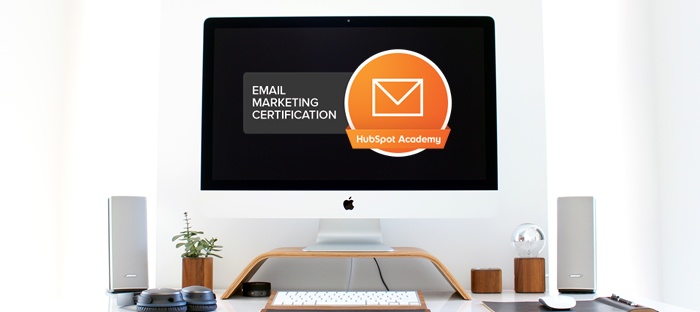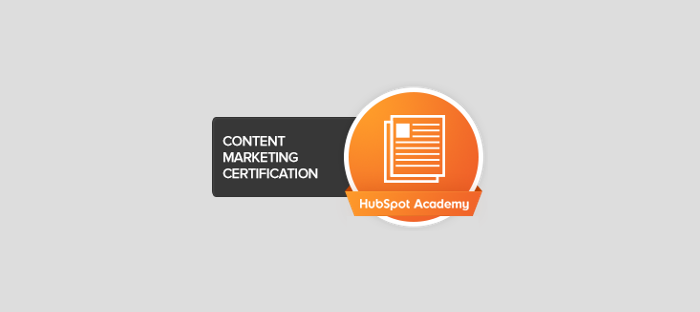Is HubSpot’s Email Marketing Certification Worth the Effort?

Despite what you may think, email marketing is not dead. In fact, with an ROI of 4,300% (yes, you read that right), email marketing is still one of the most effective ways to nurture leads and grow your business.
Given this fact (and the reality that I had nothing better to do one gloomy Saturday afternoon), I thought I’d take a stab at the HubSpot Email Marketing Certification.
The course is broken down into nine sections and consists of 27 videos, which total about three and a half hours of view time. To achieve your certification, you then need to pass a timed, 60-question exam.
So, did I learn anything new? Definitely. Do I think it’s worth the time and effort? Read on for a summary of my key takeaways and find out.
Core principles of email marketing
According to HubSpot, email marketing plays a primary role in the close and delight stages of inbound marketing, which means it’s imperative to get it right. That said, the key to creating an effective email marketing strategy lies in the following core principles:
- Your emails need to be mobile-friendly because over 54% of them will be viewed via a mobile device.
- Your contact list needs to be segmented since the context of your emails is just as important as the content.
- Personalization is a basic, yet important way to make your email contextual.
- Data-driven analytics and optimization should be an ongoing process in your email marketing efforts.
Although the course touches on some email design best practices such as the importance of using headers and whitespace, the tips they provide aren’t exactly earth-shattering. So if you’re looking to learn more about email design, you may want to check out the HubSpot CMS for Developers Certification in lieu of this one.
How to segment your email lists
Leads vs. customers
Before taking this certification, I had never heard of the term “lifecycle marketing.” In case you too are unfamiliar, HubSpot defines it as “how you communicate with your contacts – from their first point of contact all the way through their lifespan as a paying customer.”
Why is this important, you ask? Because your leads and customers have different needs and challenges. Therefore, you should nurture them differently. HubSpot suggests the following:
- When marketing to leads, map your email content to the buyer’s journey by identifying key touchpoints such as subscribing to your blog, filling out a contact form or downloading an offer.
- When marketing to customers, make sure you’re capturing the right data and mapping out the important parts of the customer lifecycle journey. Why did your customers purchase? How can you help them be successful?
Of course, not all customers are created equal. It’s important to recognize the three customer stages and nurture each of them through different types of messaging:
- New customers should receive transactional or welcome emails. The purpose of these emails might be to confirm an appointment or recap an event.
- Existing customers should receive emails that provide value. In other words, don’t send them emails that have nothing to do with the product or service they’ve purchased from you.
- Evangelists – who are customers that believe so strongly in your product or service they convince others to buy or use it – can be created by sending emails that provide perks such as exclusive access, customer discounts or a referral program offer. As a side note, these are the customers you’ll want to hit up for testimonials, reviews or case studies.
Buyer personas
Another effective way to segment your list is by buyer persona. Some examples include:
- Company-related: Company size, company type or industry
- Role-related: Department, seniority or function
- Behavior-related: Conversion events, email opens or page views
- Marketing intelligence-related: Social media data, original source or web analytics
The more you can zone in on your lists, the better targeted your marketing becomes, which ultimately results in higher conversion rates.
Email marketing best practices
The course covers some best practices to keep in mind when creating your emails. Although these are a bit basic, I still think they’re worth mentioning.
Define a clear goal
Every email you send to your lists should have a purpose. Instead of defining your goal as a specific amount of clicks or opens, identify a goal that is quantifiable, such as registering for a webinar, downloading a white paper or subscribing to your blog. Then, focus your content on achieving that goal.
Optimize your email for opens
Craft a great subject line and add preview text to immediately engage your readers. Use personalization where appropriate, and make sure your emails are sent from a company email address as opposed to a free account like Gmail or Yahoo.
Compel your audience to take action
You’ve already defined your goal, so don’t forget to ask your readers to do it! Create a clear call-to-action that will entice them to click and complete your intended goal.
Analyze and optimize your emails
As inbound marketers, we understand the importance of gathering metrics around our marketing efforts. But sometimes, this results in us knowing the what without the why. HubSpot’s email marketing certification course covers a few common scenarios marketers experience and provides a possible explanation for each.
"My open rates are lower than expected."
- Possible problem: Bad subject line
- Solution: Write a short, to-the-point, non-salesy subject line.
"My open rate is high but my click rate is low."
- Possible problem: Your email is trying to do too many things.
- Solution: Make sure your CTA is clear.
"My click rate is high but my conversion rate is low."
- Possible problem: You have a bad landing page.
- Solution: Use landing page best practices such as a clear and compelling headline, no navigation and a form whose length mirrors the value of the offer.
Related Content: 7 Advanced Strategies for More Effective Landing Pages
The course goes on to provide a framework for performing email optimization tests, which should be an ongoing process. Overall, it’s important to:
- Start with a clean and segmented list
- Make sure your list is large enough to provide meaningful results
- Analyze the marketing funnel for opportunities
- Hypothesize and design solutions
- Check that your results are significant
Is HubSpot’s email marketing certification worth the effort?
In a nutshell, yes. The time I invested in taking this course was well worth the amount of information I gleaned on the topic of segmentation alone. I think many marketers are guilty of blindly setting up email campaigns – like throwing spaghetti at a wall – in the hopes that something will stick.
The last thing you want to do is annoy your leads and customers with emails that lend absolutely no value to them. So, avoid the messy walls and arm yourself with as much knowledge as you can before diving into your next email marketing campaign.
Another way to improve your email performance is to choose the right words for the copy you write. Download our Persuasive Copywriting Guide for terrific insight into the words and phrases that encourage your readers to take the action you want!





